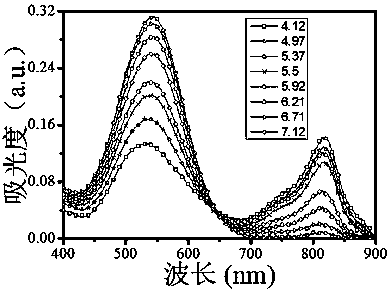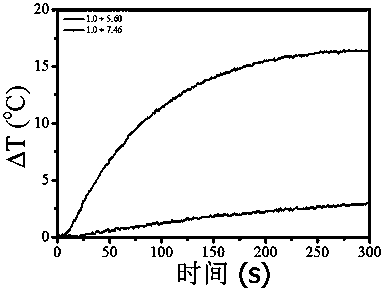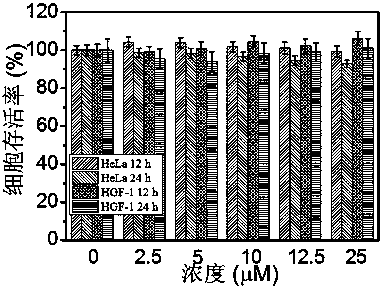Photothermal reagent for identifying tumor cells through pH control and preparation method and application thereof
A technology of photothermal reagents and tumor cells, which can be applied in the direction of antineoplastic drugs, pharmaceutical formulations, medical preparations containing active ingredients, etc., and can solve problems such as poor photostability, low photothermal conversion efficiency, and variable structure
- Summary
- Abstract
- Description
- Claims
- Application Information
AI Technical Summary
Problems solved by technology
Method used
Image
Examples
Embodiment 1
[0041] Preparation of 2-chloro-3-hydroxymethyl-cyclohex-1-ene carboxaldehyde: Prepare 40 mL of ice-cold N,N-dimethylformamide and dichloromethane mixed solution with a volume ratio of 1:1, under nitrogen protection , slowly add 20mL of phosphorus oxychloride solution dropwise, react for 30 minutes, add 20mL of cyclohexanone, stir vigorously and heat up to 80 o C reaction. After the reaction is complete, pour it into a large amount of ice water and let it stand overnight. A large amount of yellow solids are produced, and the product is obtained by filtration and washing. 1 H-NMR (300MHz, CDCl 3 ):1.57(m,2H),2.35(t,4H,J=6.3Hz),2.5(s,1H),10.10(s,1H).
Embodiment 2
[0043] Preparation of 1-(2-carboxyethyl)-2,3,3-trimethyl-4,5-phenylindole: measure 80 ml of 1,2-dichlorobenzene, add 10 mmol of 2,3,3 -Trimethyl-4,5-phenylindole and 10mmol of 3-bromopropionic acid, the mixture was stirred and heated to 80 o C, react for 20-30 hours, after the reaction is completed, filter to obtain a solid, wash with ether, and dry to obtain a solid for subsequent use; 1 HNMR (DMSO-d 6 ,400MHz):δ8.36(d,1H,J=8.37),8.273(d,1H,J=8.28),8.206(dd,2H,J=8.20),7.765(t,1H,J=7.78), 7.706(t,2H,J=7.72),4.761(t,2H,4.78),3.029(t,2H,3.05),2.97(s,3H),1.75(s,6H).
Embodiment 3
[0045] Preparation of compound PTT-pH: Dissolve 10 mmol of 2-chloro-3-hydroxymethyl-cyclohex-1-enecarboxaldehyde in 20 mL of acetic anhydride, add 10 mmol of 1-(2-carboxyethyl)-2,3 , 3-trimethyl-4,5-phenylindole and 10 mmol of 2,3,3-trimethyl-4,5-phenylindole, heat to 70 o C, react for 24 hours, extract the aqueous phase several times with dichloromethane, combine the organic phases, and dry the organic phases with anhydrous magnesium sulfate. The above solution was filtered, the filtrate was removed, and the solvent was removed in vacuo to obtain the crude product. The pure product was obtained by thin layer chromatography. 1 HNMR (DMSO-d 6 ,400MHz):δ8.42(d,1H,J=8.37),8.26(m,3H),8.05(t,4H,J=8.20),7.72(d,1H,J=7.78),7.62(t, 3H,J=7.72),7.50(t,3H,J=7.78),6.43(d,1H,J=7.05),6.29(d,1H,J=7.56),4.49(s,2H),2.74(s ,6H),1.95(s,8H),1.78(t,6H,J=8.05),ESIm / z(C 41 H 40 ClN 2 O 2 + ):calc:627.2772;found:627.2773.
PUM
 Login to View More
Login to View More Abstract
Description
Claims
Application Information
 Login to View More
Login to View More - R&D
- Intellectual Property
- Life Sciences
- Materials
- Tech Scout
- Unparalleled Data Quality
- Higher Quality Content
- 60% Fewer Hallucinations
Browse by: Latest US Patents, China's latest patents, Technical Efficacy Thesaurus, Application Domain, Technology Topic, Popular Technical Reports.
© 2025 PatSnap. All rights reserved.Legal|Privacy policy|Modern Slavery Act Transparency Statement|Sitemap|About US| Contact US: help@patsnap.com



